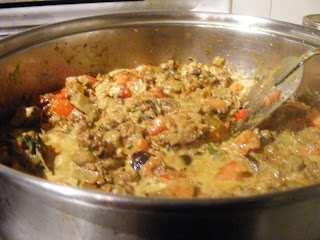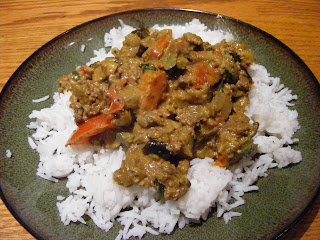 |
| Wheatless Mondays and Meatless Tuesdays were part of a voluntary food conservation scheme developed by the U.S. Food Administration during World War I |
The reasons behind the Wheatless Monday and Meatless Tuesday campaign during the first world war were pragmatic. People were starving to death in Europe because food production had been disrupted by the fighting, and many of our own troops had trouble getting enough food to eat. Refraining from meat and wheat on the American home front was considered patriotic and philanthropic, the decent thing to do: You ate less, so that others--good people who had it much worse than you did--didn't die. Your own personal well being--your health--had very little to do with it.
 |
| Refraining from wheat, meat, sugar and lard was seen as patriotic and helpful to the war effort. |
For I while, I contemplated creating a day-of-the-week cooking blog with categories like "Meatless Monday," "Toothsome Tuesday," "Wheat-less Wednesday," "French Fried Fridays"--you get the drift--if for no other reason than to poke fun at the use of alliterative soundbites to sell an eating habit. It's the commercialization of the campaign that I object to the most. I fully understand that Americans eat too much meat and saturated fats and that our "American diet" is killing us, but I also find it intrusive and not a little insulting to be subjected to Mad Men sales lines to convince me to make "better" personal choices about what I put in my own mouth.
Never mind the fact that it's almost impossible to stop thinking or obsessing about something when someone keeps talking to you about not having it. Don't call the day "meatless," call the day something else. Call it Maharani Monday (if you must use alliteration), and introduce me to the vegetarian delights of India. Tell me something interesting, something new, something I've never heard before. Don't use scare tactics. Tell me about Hindu's sacred book, the Taittiriya Upanishad, and what it says about the human body: that our physical selves are "food bodies" because we are born of food, we are sustained by food, and in due course we will become food. All food is sacred. Food is life. Food is a gift from God.
According to the Meatless Monday website, beans, collard greens and carrots may "thwart breast cancer," but that does not make me want to jump up, run to the kitchen, and cook up a batch. The message does nothing to motivate my food choices. Though I love beans and rice and adore fresh greens, their message about breast cancer makes me turn up my nose. I do not want to think about cancer, however theoretical, whilst dining on beans and greens . . . or anything else, for that matter. I'd be willing to bet that most Americans would rather listen to a quasi-religious discourse on the sacredness of our bodies and its natural connection to food than to listen to the Meatless Monday folks tell them once again that 1/3 of all American adults will have diabetes by 2050, that more of us have heart disease than ever before, and (fear mongering at its worst:) that our children will die young because they're fat. Talk about a gastronomic buzz kill!
I love Indian food because it does not ask me to eat less meat. Instead, it asks me to enjoy the flavors, textures, and fragrance of real (sacred) food--vegetables, grains, legumes, and even animal flesh. If a dish calls for meat, it does not usually call for a lot of it. If a dish calls for a vegetable, that vegetable is celebrated, lifted to the heavens. If you don't want to eat meat, substitute vegetables. No problem. Got a hankering for chicken? Add some. At table, everything is served over rice or with wonderful, simple flatbreads.
Like our own World War I federal food agency, Indian cuisine asks us to be thrifty and thoughtful and even respectful of everything we choose to consume.
 |
| World War I propaganda from the U.S. Food Administration. |
Ground Lamb with Fragrant Spice Almond Sauce
- 4 tablespoons vegetable oil
- 1 large onion, diced fine
- 6 cloves of garlic, minced
- 1 inch piece piece of fresh ginger root, peeled and minced
- 1 large fresh jalapeno, seeded and minced
- 1 lb. ground lamb
- 1 medium eggplant, diced (salted and drained in a colander for 20 minutes, then rinsed)
Heat the oil, then add the onion, garlic, ginger, and jalapeno. Fry over medium heat until the onion is translucent. Add the ground lamb and diced eggplant. Continue to fry and break up the meat over medium heat until the meat is browned and the eggplant is soft.
Add the following spices to the mixture:
- 1/4 teaspoon ground clove
- 1/2 teaspoon ground cardomom
- 2 bay leaves
- 1/2 teaspoon ground cinnamon
- 2 1/2 teaspoons garam masala
- 4 teaspoons ground coriander
- 1 1/2 teaspoons ground tumeric
- 1 teaspoon paprika
Stir and fry until the spice fragrance begins to "bloom." Add the following:
- 2 medium tomatoes, diced
- 1 cup plain (NOT vanilla, but "plain") Greek-style yogurt
Warm through, then stir in:
- 6 tablespoons ground almonds
- salt to taste
- 1/4 cup finely chopped fresh mint leaves
Tomorrow, I'll go all vegetarian, tackling two of my favorite childhood favorites: Dal and Palak Paneer!


No comments:
Post a Comment